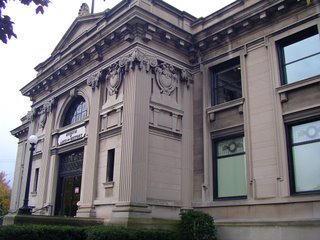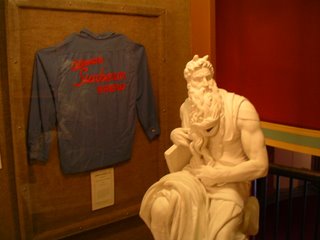 We were in Port Huron, MI, over the weekend with a couple of hours to kill before a family event. So we headed to the Museum of Arts and History, hoping to learn something about the local arts and history. Instead, what we found inside the building was perhaps the most random and disassociated collection of non-related items we've seen anywhere, except for weekend flea markets along the Tennessee interstate.
We were in Port Huron, MI, over the weekend with a couple of hours to kill before a family event. So we headed to the Museum of Arts and History, hoping to learn something about the local arts and history. Instead, what we found inside the building was perhaps the most random and disassociated collection of non-related items we've seen anywhere, except for weekend flea markets along the Tennessee interstate. The building housing the museum is remarkable. Built as a library in 1902 with massive blocks of Indiana limestone, it was paid for by Andrew Carnegie, the steel baron turned philanthropist who gave away his $350 million fortune before he died in 1915. In addition to the numerous highly-regarded institutions he created (Carnegie Hall and Carnegie Mellon University are among the many), three thousand of his libraries dot small towns across the U.S. and Europe. And judging from Port Huron structure, Carnegie spared no expense.
The building housing the museum is remarkable. Built as a library in 1902 with massive blocks of Indiana limestone, it was paid for by Andrew Carnegie, the steel baron turned philanthropist who gave away his $350 million fortune before he died in 1915. In addition to the numerous highly-regarded institutions he created (Carnegie Hall and Carnegie Mellon University are among the many), three thousand of his libraries dot small towns across the U.S. and Europe. And judging from Port Huron structure, Carnegie spared no expense. The library moved to a new and larger building in the 1960's, and so the building converted into a museum. We expected to find a regal collection of art and historical items inside, the kind that would illuminate Port Huron's rich history- first as trading post and fort in the 1700's and later as an affluent shipping hub in the golden era of the Great Lakes maritime transportation industry. While items from those days were on display, the exhibits were weighted heavily with the obscure and the irrelevant, often with complete disassociation: a porcelein doll collection is on display between miniature wooden ships and a violin shop; the iron lung machine (seen here) sits under a trophy muskellunge mount.
The library moved to a new and larger building in the 1960's, and so the building converted into a museum. We expected to find a regal collection of art and historical items inside, the kind that would illuminate Port Huron's rich history- first as trading post and fort in the 1700's and later as an affluent shipping hub in the golden era of the Great Lakes maritime transportation industry. While items from those days were on display, the exhibits were weighted heavily with the obscure and the irrelevant, often with complete disassociation: a porcelein doll collection is on display between miniature wooden ships and a violin shop; the iron lung machine (seen here) sits under a trophy muskellunge mount. Nestled between the World War II diorama and the Ladies of the Maccabee booth is the natural history collection. Various mammals sit encased in glass, many covered in dust and some so frail the hair has fallen off like they were siblings of the Velveteen rabbit. Framed butterflies cover the walls, many so old they've disintegrated into particulated ghosts. An elephant skull (presumably from Africa) sits on the ground next to mastodon bones recovered from a nearby farm. No attempt is made to illustrate where any these critters lived, how they lived, or what their connection is to the area. A school kid would leave the museum thinking elephants once roamed the banks of the St. Clair River alongside mastodons.
Nestled between the World War II diorama and the Ladies of the Maccabee booth is the natural history collection. Various mammals sit encased in glass, many covered in dust and some so frail the hair has fallen off like they were siblings of the Velveteen rabbit. Framed butterflies cover the walls, many so old they've disintegrated into particulated ghosts. An elephant skull (presumably from Africa) sits on the ground next to mastodon bones recovered from a nearby farm. No attempt is made to illustrate where any these critters lived, how they lived, or what their connection is to the area. A school kid would leave the museum thinking elephants once roamed the banks of the St. Clair River alongside mastodons. Upstairs, things get even more confusing. A Greek statue of a bearded gent with a tablet (we don't know our Greek fellows by sight, but he was probably a philosopher who profoundly influenced modern thought), is perched next to a Clikman's Sunbeam Bread shirt. If there is a connection between the two, it doesn't get transmitted, leaving us to come up with our own: in addition to being punctual and friendly, truck drivers at Clikman's were the intellectual giants of their time.
Upstairs, things get even more confusing. A Greek statue of a bearded gent with a tablet (we don't know our Greek fellows by sight, but he was probably a philosopher who profoundly influenced modern thought), is perched next to a Clikman's Sunbeam Bread shirt. If there is a connection between the two, it doesn't get transmitted, leaving us to come up with our own: in addition to being punctual and friendly, truck drivers at Clikman's were the intellectual giants of their time. The "Arts" section of the museum was equally bizarre. As soon as we saw it was a hodgepodge of middle school art class submissions and the old paintings seen at any VFW hall, we turned and headed towards the door. We assume that's what this bronze statue is trying to do as well. But he's forever trapped amongst this most incongruant collection of common attic artifacts and garage sale artwork.
The "Arts" section of the museum was equally bizarre. As soon as we saw it was a hodgepodge of middle school art class submissions and the old paintings seen at any VFW hall, we turned and headed towards the door. We assume that's what this bronze statue is trying to do as well. But he's forever trapped amongst this most incongruant collection of common attic artifacts and garage sale artwork.
skip to main |
skip to sidebar
Pithy Banter and Less Than Inspired Photography

